Entries tagged with “p100”.
Did you find what you wanted?
Wed 1 May 2013
Posted by admin under Air Monitoring, Exposure, fit testing, Management, N95, PEL (Perm Exp Limit), Personal Protective Equip (PPE), Respirators, Safety Policies, Safety Programs, Training, Uncategorized
Comments Off on When is fit testing NOT required?
There are only a few instances when you are not required to perform fit testing. The main reason not to perform fit testing is if the employees are wearing a respirator voluntary. (meaning: it’s not required)
So, how do you know if it’s required? It’s required when:
- You have overexposures to a substance (it’s required by OSHA to wear a respirator- so make sure you know, perform air monitoring), or
- If everyone is wearing a respirator during this task (it’s probably also required, just not formally- ie. spray finishing, or my favorite sanding drywall dust) or,
- If your company policy requires them to be worn (management says: it’s required to wearing a respirator during this task).
So, if you choose voluntary to wear a respirator and there is NOT a policy, or law, that says you HAVE to wear one then, you don’t need fit testing. (but you do need a few other things, Appendix D, etc.)
There is only one other exception: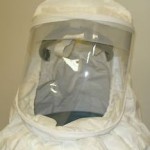
- loose fitting hooded /helmet atmosphere supply respirators (when used in areas not immediately dangerous to life and health (IDLH))
Some employers choose to use these types of respirators because:
- the employee wears a beard
- it is convenient to use
- offers eye/face/neck protection
- it offers a greater protection factor
- it’s easier to don/doff (take on/off)
These guidelines for fit testing are different than medial testing before wearing a respirator, as spoken about here.
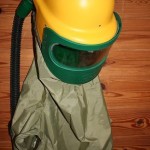
Wed 25 Apr 2012
This blog-post is directed to employees….the drywall framers, hangers, tapers, fireproofers & plasteres who sand and finish mud & drywall.
Question: What type of respirator do you wear when you sand?
…answer? Anything I can find.
This question misleading… and is similar to the one where the attorney asks in divorce court, “Do you beat your wife only when you’re drunk, or all the time?”
But, reiterate.  Do you ever NOT wear a respirator when sanding? Answer: No. We always wear a respirator. It’s dusty.
So if I may ask a leading question (as a bad attorney): What type of respirator would you wear if you were worried about OVERexposure?
Answer: a tight fitting 1/2 face (or full face, for eye protection & fogging control) negative pressure respirator with HEPA cartridges.
I think I’ve made my point. Why would you choose a paper dust mask? The fit is mediocre, they are disposable, you cannot fit test them (very well). Who cares if it’s a N95 or P100. You can feel the dust escaping around your nose. Below are some “average” pictures of people sanding. What will you do?  more info here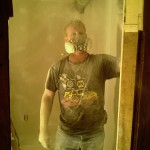

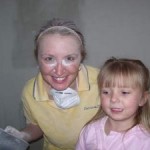
Tags: drywall, dust, fit test, framer, hanger, HEPA, IOM, mud, n95, p100, plaster, PPE, respirator, sand, sanding, tape, taper, tight fitting
Tue 21 Feb 2012
There is much confusion over the requirements and best practices of employees using respirators voluntarily.
Let me first clarify.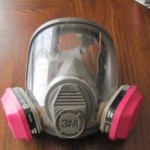 You must do air monitoring (or have other verifiable information) that employees are not REQUIRED to wear respirators (if they are overexposed to something, you must protect them). Also, they cannot voluntarily wear a respirators if there is a known hazard above the exposure limit (the employee cannot opt-out of wearing a respirator and be overexposed).
You must do air monitoring (or have other verifiable information) that employees are not REQUIRED to wear respirators (if they are overexposed to something, you must protect them). Also, they cannot voluntarily wear a respirators if there is a known hazard above the exposure limit (the employee cannot opt-out of wearing a respirator and be overexposed).
Some points about voluntary use:
- Assuming the above statement (s) is true, firstly, you do not have to allow them to wear respirators. I am sure this is arguable from a human resources/PR/legal stance. However, if you have documented no overexposure and have not provided a respirator, they should not need to wear one.
- Next, the employees need to be educated and you need to prove it. Having them sign Appendix D of the OSHA respiratory rule is a minimum. Training them would be better.
- What respirator are they wearing? A paper dust mask (N95, P100, or similar) is a respirator. If they are wearing anything other than this type of mask they need a medical evaluation (Appendix C of respiratory standard).
- If they are wearing a 1/2 face tight fitting negative pressure respirators (or more protective ones) the company needs to have a written respiratory program.
- Fit testing is not required to be performed
- Maintenance, inspection, storage, and training should always be done. Can you verify that the employee does this?
 I personally do not recommend the paper dust masks (N95, or similar) for this simple reason. Why would you wear this type of respirator if you could have a 1/2 face, tight fitting one with the correct cartridge? The cost difference is negligible, the protection is better, and you can be assured of a better fit. If you’re going to do it, do it right.
I personally do not recommend the paper dust masks (N95, or similar) for this simple reason. Why would you wear this type of respirator if you could have a 1/2 face, tight fitting one with the correct cartridge? The cost difference is negligible, the protection is better, and you can be assured of a better fit. If you’re going to do it, do it right.






